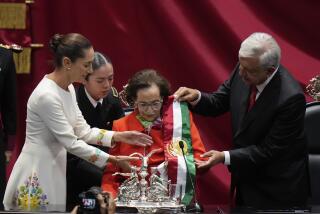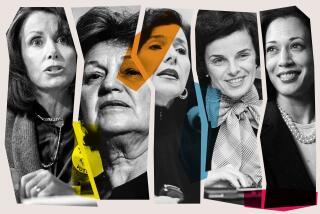In Latin America, Daughters Redefine Persona of First Ladies
- Share via
LIMA, Peru — One by one, President Alberto Fujimori banished his wife, his brother, his longtime friends and even his spy chief, Vladimiro Montesinos, until he had only a single ally left.
In the weeks since the political crisis that led to Montesinos’ firing, 23-year-old Keiko Fujimori--Peru’s slightly chubby, sometimes shy first lady--has emerged as her father’s spokeswoman and, from all appearances, closest confidant.
She held the president’s hand throughout his September announcement that he would disband Peru’s spy agency and abort the third term that he had won in elections widely considered fraudulent.
Then she made the rounds of local television stations, giving his side of the events leading up to his decision to step down. Most recently, she has accompanied her father as he led the search for Montesinos, who returned to Peru last month amid speculation that he may try to undermine Fujimori.
It was a new role for a young woman whom Peruvians had considered ornamental and whom outsiders had seen only as part of an unusual clique of Latin American daughters-cum-first-ladies. At presidential inaugurations and regional summits, they were often seated together, looking like a table of debutantes. Keiko Fujimori is the only remaining first lady in the group of daughters that included Maria Dolores Aleman of Nicaragua, Zulemita Menem of Argentina and Paola Mahuad of Ecuador.
Wives Use Groups to Bolster Government
Like Aleman--who stepped aside when her father remarried a year ago--Keiko Fujimori is proving that she can be a formidable political asset to her father during times of crisis. As a result, both U.S.-educated women have sparked controversy.
Combining youthful enthusiasm with a daughter’s unflinching loyalty, they bring into stark relief the most questionable aspects of a first lady’s traditional role in Latin America. Throughout the region, when presidents take power, their wives become the heads of government-financed charitable organizations that are often used to bolster support for the government among the poorest citizens.
The organizations generally are not subject to the same budget controls as government agencies, and their priorities and use of funds are often murky.
“Because they do the charitable work, they are part of the patronage in politics” in Peru, where presidents’ wives have played important political roles for the past 50 years, said Fujimori biographer Luis Jochamowitz. “There is a bit of influence trafficking involved” because the first lady is the way to bring petitions directly to the president’s attention.
While a politician’s wife might choose to support her husband in that way, critics contend that a father shouldn’t ask that of his daughter.
“They are the good facades for bad presidents,” said Wilma Nunez, director of the nongovernmental Center for Human Rights in Nicaragua, where Aleman was first lady during the first three years of her father’s presidency.
“In President [Arnoldo] Aleman’s case, he should have been more careful about his daughter,” Nunez said. “She seems to be a capable, intelligent young woman, and he made her take the brunt of his own lack of popularity.”
Mexican President-elect Vicente Fox appears to have taken that perspective seriously, quashing speculation that his 20-year-old daughter, Ana Cristina, will be first lady. Professionals will run the family welfare agency that has traditionally been the turf of presidents’ wives, he decided.
“She has her own life,” he told the newspaper Reforma in a July interview that ruled out Ana Cristina for the post. “She is studying law.”
Maria Dolores Aleman, a graduate of Xavier University in Cincinnati, earned a graduate degree in international relations at Nicaragua’s University of Central America while she was first lady.
She acknowledges that she felt the pressure of expectations, heightened by the fact that, for nearly two decades, Nicaragua had no first lady.
Her father’s predecessor, widow Violeta Barrios de Chamorro, didn’t fill the post. Rosario Murrillo--the companion of Chamorro’s predecessor, Daniel Ortega--held Cabinet positions rather than performing the traditional charity tasks of a president’s wife.
“Everybody was watching me,” the 26-year-old recalled during an interview at her new office, where she runs a health clinic for her father’s Liberal Alliance Party. “I would go into the supermarket to shop, and everyone pointed at me.”
Two years into her father’s term, the pressure grew when the region’s most devastating storm in two centuries flooded Nicaragua, leaving thousands dead. Amalia Frech, a longtime family friend who is executive director of the government’s National Commission for the Defense of Children’s Rights, worked closely with the president’s daughter during the 18-hour days that followed the storm.
“She had tremendous energy,” Frech recalled. Because the first lady’s office handled much of the distribution of international donations, Maria Dolores Aleman became the target of critics who contended that her father’s supporters received more relief distributions than other victims and that the government took credit for goods that had been sent from abroad.
“I’m used to criticism,” the younger Aleman said, with the aplomb of the experienced politician she is. “But if people want to criticize, they should tell me how to do it better.”
She fondly remembers the friendships she formed at the daughters/first ladies’ table of those three years. “Paola [Mahuad] was barely out of high school, but she had a real desire to work,” Maria Dolores Aleman said.
Until her father was replaced by his vice president in a coup earlier this year, Paola Mahuad was attending law school in the morning and working at a foundation to help pregnant teens in the afternoon.
“I was not that close” to Zulemita Menem, Maria Dolores Aleman said. “I felt that she was there mainly to support her father. . . . I identified most with Keiko.”
Keiko Fujimori was in her final year at Boston University in 1994 when her parents separated in a bitter, highly public divorce and her father asked her to take on the role of first lady. Keiko Fujimori often had to study on planes as she flew to Latin America on weekends to attend official gatherings, Maria Dolores Aleman recalled.
Daughter Avoids Being Target of Hate
After the ugly separation, said Fujimori biographer Sally Bowen, the president “thought it was charming to take his daughter around to these events.”
At first, Bowen said, “she did nothing but smile sweetly.” Keiko Fujimori was sometimes criticized in gossip columns for wearing bright colors despite being overweight, but nothing more, Bowen said.
Despite the hate that has built in Peru toward the president, Jochamowitz noted, “she has managed not to be despicable, and that certainly has merit.”
Keiko Fujimori has indicated in recent interviews that behind the scenes, she was playing a more important role, warning her father about his notorious spy chief, suspected by many observers of overseeing the repression that kept the president in power.
“People began to tell me of suspicions that they could not prove about Dr. Montesinos,” she said in an appearance on the all-news cable channel, Canal N. “Suddenly, I opened my eyes and realized that the person my father trusted was not completely loyal. How was I going to tell him?”
When she began to warn her father about Montesinos, the security director tried to have her exiled, alleging that she wasn’t safe in Peru, she said with a smile that indicated she didn’t quite believe in his concern for her safety.
But her involvement in politics has come at a cost. For the first time, disparaging comments about her appeared on a downtown wall of political graffiti.
“He’s co-opted her into being his mouthpiece,” Bowen said. “People think that it’s sweet she should assert that her father knew nothing about what Montesinos was doing, but they don’t believe it.”
More to Read
Sign up for Essential California
The most important California stories and recommendations in your inbox every morning.
You may occasionally receive promotional content from the Los Angeles Times.













